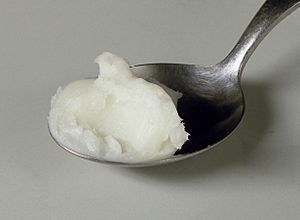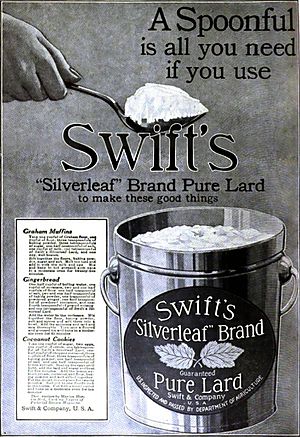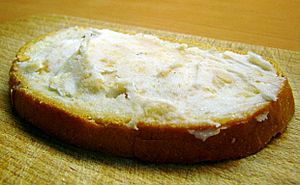Lard facts for kids
Lard is a type of fat that comes from pigs. People use it a lot in cooking. Long ago, many different cuisines used lard as a cooking fat or shortening. It was also used as a spread, much like butter. Today, it's not used as much as it used to be. However, many cooks and bakers still prefer it over other fats for certain dishes because of its special qualities.
Cooking with Lard
Lard is one of the few edible fats that can get very hot before it starts to smoke. This is because it has a lot of saturated fats. Pure lard is great for cooking because it doesn't smoke much when heated. It also adds a unique flavor to food. Many chefs and bakers really like lard more than other shortenings because of its taste and how many ways they can use it.
Lard has larger fat crystals compared to other fats, which makes it very good for baking. For example, pie crusts made with lard often turn out flakier than those made with butter. Some cooks even use both lard and butter in their pastries. This way, they get the flakiness from lard and the nice flavor from butter.
Lard was once very popular in the cooking of Europe, China, and the Americas. It still plays a big part in British, Central European, Mexican, and Chinese cooking. In Britain, lard is a traditional ingredient in mince pies and Christmas puddings. It's also used in lardy cake and for frying fish and chips. Some people in England even eat plain lard! There's even a "Lard Championships" held every year in Dorset, where thousands of people gather.
In Scandinavia, lard is a main ingredient in a type of pâté called leverpostej.
In Spain, a popular breakfast in Andalusia includes different kinds of mantecas. These are seasoned lards spread on toasted bread. Two popular types are manteca colorá (lard with paprika) and zurrapa de lomo (lard with pork flakes). In Catalan cuisine, lard is used to make the dough for a pastry called coca. On the Balearic Islands, the dough for ensaimades also contains lard.
Eating lard as a spread on bread used to be very common in Europe and North America. This was especially true in places where dairy fats and vegetable oils were hard to find.
Today, more high-end restaurants are looking for lard. Because of this, some small farmers are now raising special pig breeds. These pigs, like the Mangalitsa hog from Hungary or the Large Black pig from Great Britain, have more body fat. These breeds are becoming very popular again, so much so that farmers can barely keep up with the demand.
When people just say "lard" in English, they usually mean "wet-rendered" lard. This type has a very mild, neutral taste. Another type is "dry-rendered" lard, also called dripping, which has a stronger pork flavor. Dripping sandwiches are still popular in some European countries. For example, in Hungary, they have zsíroskenyér ("lardy bread"). In Germany, they have "Fettbemme," which is seasoned pork fat. Similar snacks are sometimes eaten with beer in Poland, the Czech Republic, and Slovakia. These are often topped with onions, salt, and paprika.
In Taiwan, Hong Kong, Macao, and many parts of China, lard was often mixed into cooked rice with soy sauce. This dish is called "lard rice" (豬油拌飯 or 豬油撈飯). In Japan, back loin lard is often used for ramen. It makes the dish thick, nutty, slightly sweet, and very hearty.
Traditionally, along with peanut oil, lard is widely used in Asian cooking. It's a common cooking oil for stir-fries and deep-frying.

In Germany, lard is called Schweineschmalz. This means "rendered fat from swine." It has been a favorite spread for a long time. It can be eaten plain, or it can be mixed with other flavors. Sometimes, small crispy pieces of pork skin, called Grieben, are added to make Griebenschmalz. Other recipes include small pieces of apple or onion. In English, however, schmaltz usually refers to fat from chicken, duck, or goose.
Schmalzbrot ("bread with Schmalz") can be found in restaurants and pubs in Germany. It's often served as Griebenschmalz on rye bread with a pickled gherkin.
Sometimes, people make vegetarian Grieben from onions or apples. This started as a way to make Schmalz go further when food was scarce. But it became popular on its own because it gives a special taste and has less fat. There are also completely vegetarian Schmalz-like spreads made from vegetable fats. In Germany, it's not allowed to call non-lard products "Schmalz."
In Poland, lard is often served as a starter. It's mixed with fruit, usually chopped apple, and spread on thick slices of bread.
Other Uses for Lard
Rendered lard can also be used to make biofuel and soap. Lard is also helpful as a cutting fluid in machining, which is when machines cut and shape metal. Its use in machining has gone down since the mid-1900s because other special cutting fluids were invented. However, it's still a good option. Lard and other animal fats were once used to stop foam from forming in industrial processes like brewing. Now, other substances like polyethers are used instead.
Images for kids
-
A triglyceride molecule, which is the main part of lard.
See also
 In Spanish: Manteca de cerdo para niños
In Spanish: Manteca de cerdo para niños






